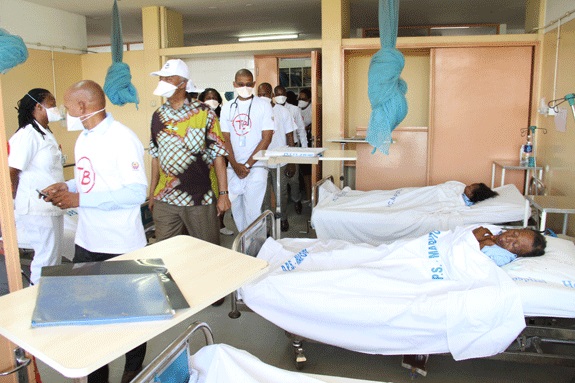27Nov2017
Hypoglycaemic activity of Commelina africana
by admin, 0 Comments

Hypoglycaemic activity of Commelina africana and Ageratum conyzoides in relation to their mineral composition
OS Agunbiade, OM Ojezele, JO Ojezele, AY Ajayi
Abstract
Background: Many plants with antidiabetic properties probably act in part through their content of fibre, vitamins, bioactive or mineral content
Objectives: This study investigated the mineral, proximate, phytochemical compositions and hypoglycaemic effect of Commelina africana and Ageratum conyzoides extracts in diabetic rats, and the likely relationship between this property and the mineral, proximate and phytochemical compositions of the plants.
Methods: The plants were subjected to mineral, proximate composition and phytochemical analysis. Attempt was made to see (if any) the relationship between the hypoglycaemic effect and the mineral, proximate compositions and phytochemistry of the plants. Alloxan-induced diabetic animals were administered 500mg/kg body weight aqueous extracts of the plants and glibenclamide as the reference hypoglycaemic agent.
Results: Aqueous extract of Ageratum conyzoides reduced fasting blood glucose of experimental animals by 39.1% while Commelina africana reduced the same by 78.0%. Alkaloids, cardenolides, saponins, and tannins were detected in both plants. Anthraquinones was absent in C. africana but a trace of it was detected in A. conyzoides. The hypoglycaemic effect of Commelina africana was comparable with the reference hypoglycaemic agent. Ageratum conyzoides showed comparably weaker hypoglycaemic effect than exhibited by reference hypoglycaemic agent. Comparatively, Commelina africana had higher mineral concentrations (except Na) than Ageratum conyzoides.
Conclusions: Plants’ extracts minerals (magnesium, potassium and iron) and bioactive components (alkaloids and cardenolides) seemingly enhanced their hypoglycaemic effect. Furthermore, these minerals, alkaloids and cardenolides could be helpful in ameliorating complications of diabetes like hypertension and cardiovascular disease.
Keywords: Commelina africana, Ageratum conyzoides, diabetes
Recent Posts
- Editor’s choice: Tackling infectious diseases, NCDs and sexual reproductivehealth issues as we enter our 24th year of remarkable growth
- Preconception and contraceptive care for women living with HIV/AIDSattending antiretroviral treatment clinics in Lagos State, Nigeria
- Effects of SNPs on TNF-α and IL-10 cytokine expression in TB and HIVpatients in the Capricorn district, Limpopo Province, South Africa
- Prevalence of Schistosomiasis in a neglected community, South western Nigeria at two points in time, spaced three years apart
- Review of Leishmaniasis in the Middle East and North Africa
Recent Comments
Categories
- 2001 Issues
- 2002 Issues
- 2003 Issues
- 2004 Issues
- 2005 Issues
- 2006 Issues
- 2007 Issues
- 2008 Issues
- 2009 Issues
- 2010 Issues
- 2011 Issues
- 2012 Issues
- 2013 Issues
- 2014 Issues
- 2015 Issues
- 2016 Issues
- 2017 Issues
- 2018 Issues
- 2019 Issues
- 2024 Issues
- Articles
- December issue
- December Release
- June Issue
- June Release
- March Issue
- March Issue
- March Release
- News
- number / volume 2
- number /volume 1
- number /volume 1
- number /volume 1 2008
- number 1
- number 1
- number 1
- number 1
- number 1
- number 1
- number 1
- number 2
- number 2
- number 2
- number 2
- number 2
- number 2
- number 2
- number 2 special Issue
- number 2 special Issue 2
- number 3
- number 3
- number 3
- number 3
- number 3
- number 3
- number 3
- number 4
- number 4
- number 4
- number 4
- number 4
- number 4
- number/ volume 3 2008
- number/ volume 4 2008
- number/volume 1
- number/volume 1
- number/volume 2
- number/volume 2
- number/volume 2 2008
- number/volume 3
- number/volume 3
- number/volume 3
- number/volume 4
- number/volume1
- September Issue
- September Release
- Special Edition
- special Issue
- Uncategorized
- Vol. 24 No. 1 (2024)
- volume 1
- volume 1
- volume 1
- volume 2
- volume 2
- volume 2
- volume 2
- volume 2
- volume 3
- volume 3
- volume 3
- volume 3
- volume 4
- volume 4
- volume 4
- volume 4
- volume1
Categories
- 2001 Issues
- 2002 Issues
- 2003 Issues
- 2004 Issues
- 2005 Issues
- 2006 Issues
- 2007 Issues
- 2008 Issues
- 2009 Issues
- 2010 Issues
- 2011 Issues
- 2012 Issues
- 2013 Issues
- 2014 Issues
- 2015 Issues
- 2016 Issues
- 2017 Issues
- 2018 Issues
- 2019 Issues
- 2024 Issues
- Articles
- December issue
- December Release
- June Issue
- June Release
- March Issue
- March Issue
- March Release
- News
- number / volume 2
- number /volume 1
- number /volume 1
- number /volume 1 2008
- number 1
- number 1
- number 1
- number 1
- number 1
- number 1
- number 1
- number 2
- number 2
- number 2
- number 2
- number 2
- number 2
- number 2
- number 2 special Issue
- number 2 special Issue 2
- number 3
- number 3
- number 3
- number 3
- number 3
- number 3
- number 3
- number 4
- number 4
- number 4
- number 4
- number 4
- number 4
- number/ volume 3 2008
- number/ volume 4 2008
- number/volume 1
- number/volume 1
- number/volume 2
- number/volume 2
- number/volume 2 2008
- number/volume 3
- number/volume 3
- number/volume 3
- number/volume 4
- number/volume1
- September Issue
- September Release
- Special Edition
- special Issue
- Uncategorized
- Vol. 24 No. 1 (2024)
- volume 1
- volume 1
- volume 1
- volume 2
- volume 2
- volume 2
- volume 2
- volume 2
- volume 3
- volume 3
- volume 3
- volume 3
- volume 4
- volume 4
- volume 4
- volume 4
- volume1
